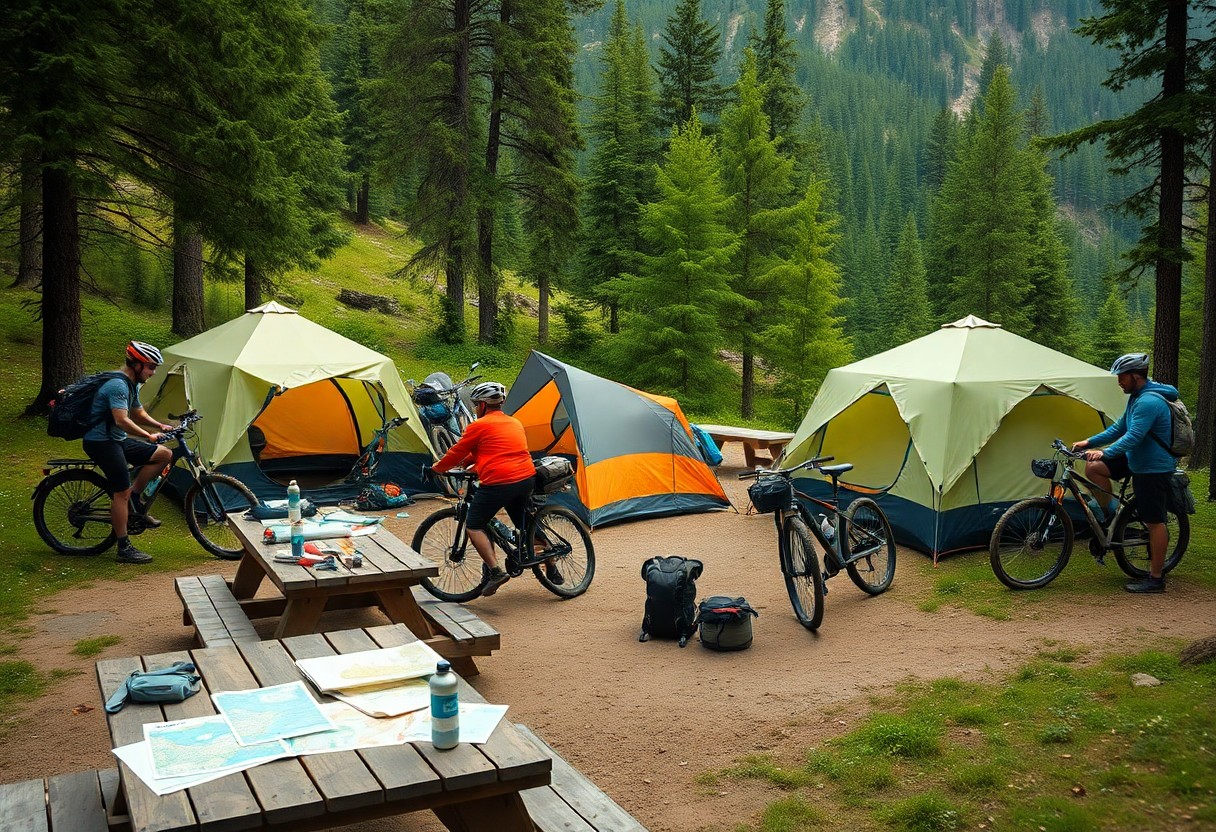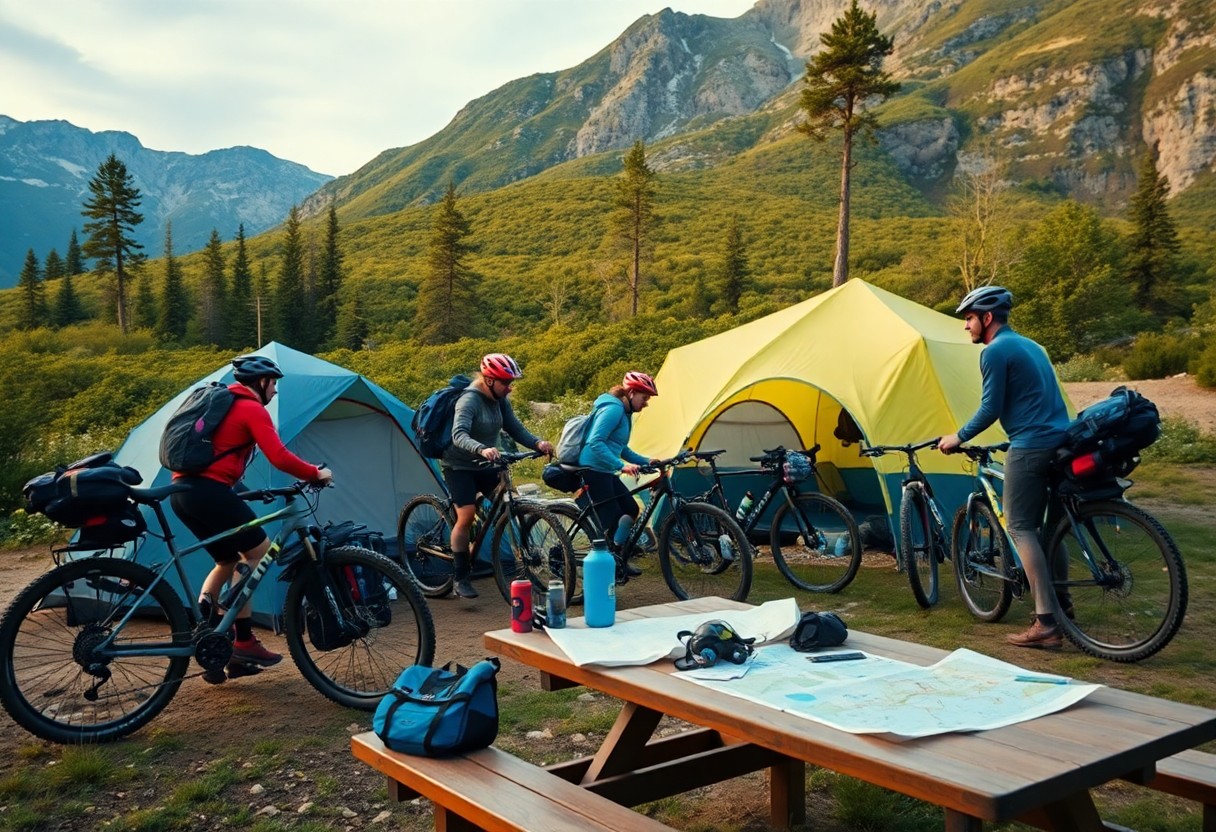This guide will equip you with the important steps to effectively plan a bikepacking trip from scratch. Understanding your route is vital, as it lays the foundation for your adventure, while physical preparation ensures you can tackle diverse terrains safely. You’ll need to consider gear and supplies for comfort and safety, making sure you’re well-prepared for unexpected challenges. By following these guidelines, you can create a memorable and enjoyable experience as you explore the open road on two wheels.
Crafting the Perfect Itinerary
Creating a well-structured itinerary is crucial to enjoy your bikepacking adventure. Gather information about the landscapes, terrain, and points of interest along your route. This will allow you to create a day-by-day plan that includes not just cycling but also time for exploration and rest. Balance your ambitions with realities, ensuring you allocate enough time for meals, breaks, and potential detours. Having a flexible itinerary allows you to adapt to unforeseen circumstances, making your experience both enjoyable and adventurous.
Determining the Route: Scenic vs. Practical Choices
Choosing the right route can make or break your bikepacking experience. Consider whether you prefer stunning views and less travelled paths or the shortest and most direct way to your destination. Scenic routes often come with breathtaking landscapes but may lack amenities or present physical challenges. Practical choices can lead you through better-maintained roads and facilities, allowing for a more comfortable journey. Ultimately, weigh your priorities based on your preferences and skill level to craft a route that fits your biking style.
Estimating Daily Mileage: Balancing Adventure with Feasibility
Your daily mileage is a significant factor in planning. Assess your fitness level, the difficulty of the terrain, and how much time you want to spend each day cycling. A comfortable daily distance usually falls between 50 to 70 kilometres for most cyclists, allowing for breaks and sightseeing. However, if you’re feeling ambitious or face challenging terrain, factor in more time and lower mileage to maintain enjoyment. Striking a balance between adventure and feasibility ensures you can embrace the journey without overstretching yourself.
Establishing your daily mileage involves more than simply jotting down distances. Start by considering your average speed; many cyclists manage about 12 to 20 km/h on varied terrain. If you aim for a daily ride of 60 km, plan for about 5 to 6 hours in the saddle, factoring in breaks for meals and rest. Be mindful of your energy levels throughout the trip, especially on challenging days when steep climbs or rough paths may slow your pace. Consult local maps to identify possible stops or hidden gems that could enrich your journey, making your bikepacking adventure both rewarding and manageable.
Essential Gear Selection: What to Pack for Success
Packing the right gear is fundamental to the success of your bikepacking adventure. Prioritise lightweight and multifunctional items to keep your load manageable, ensuring comfort and efficiency throughout your journey. Create a checklist that includes necessarys such as a reliable bike repair kit, a durable tent, and suitable clothing for varying weather conditions. Investing in quality gear will enhance your experience, allowing you to focus on the ride and the stunning surroundings.
Must-Have Bike Accessories for Performance and Comfort
Accessory selection plays a significant role in your overall bikepacking experience. Opt for quality grips for better control, a reliable pump to maintain tyre pressure, and a sturdy handlebar bag for easy access to necessarys. Consider a GPS device or smartphone holder for navigation, together with a well-designed water bottle cage for hydration on the go. Each item contributes to enhanced performance and increased comfort during long rides.
Camping Essentials: How to Choose Lightweight yet Durable Gear
Choosing lightweight yet durable camping gear is necessary to avoid unnecessary strain on your bike. Seek items made from high-quality materials like nylon or ripstop fabrics, which strike a balance between portability and durability. A tent under two kilograms will provide shelter without overwhelming your load, while a compact sleeping bag with a down fill offers warmth without added weight. Focus on items that can withstand the elements yet easily pack away without fuss, ensuring comfort in your camping setup.
When assessing camping gear, look for versatility in functionality; for example, a multi-tool can serve as both kitchenware and a repair kit, reducing the number of items in your pack. Lightweight cooking systems that nest together can also save space, allowing you to enjoy warm meals while minimising your carry weight. Always choose equipment with a good balance between weight and capability, as this strategy will allow you to navigate your routes with greater ease and confidence.
Nutritional Strategies: Eating Well on the Road
Nourishing your body while bikepacking plays a significant role in keeping your energy levels high and enhancing your overall experience. Focus on consuming nutrient-dense foods that provide sustained energy and support recovery. Prioritising a well-rounded diet with plenty of carbohydrates, proteins, and healthy fats ensures that you fuel your rides properly. Take advantage of readily available options like energy bars, trail mixes, and dehydrated meals that are lightweight and easy to pack.
Meal Planning: Easy and Nutritious Options for Sustained Energy
Effective meal planning is imperative to ensure you have easy-to-prepare and nutritious meals on your journey. Consider quick-cook grains like couscous or instant rice, paired with nut butter, dehydrated vegetables, and a variety of protein sources such as beans or jerky. Preparing some meals at home before your trip can save time and minimise bulk. For snacks, think about energy bars or fruit that travel well, like apples or bananas, giving you a robust energy source throughout the day.
Hydration Hacks: Staying Refreshed while Minimising Weight
Keeping hydrated without overloading your pack is imperative for any bikepacking journey. One method is to use water purification tablets or a lightweight filter system, enabling you to refill your water supply from natural sources along the way. Opt for collapsible water bottles or a hydration bladder, which are both lightweight and space-saving. It’s also wise to carry electrolytes in powdered form to mix with your water, helping to maintain hydration levels and replace lost salts efficiently.
Using hydration strategies tailored for bikepacking not only boosts your energy but also reduces the weight you carry. A compact filter system or pump allows you to fill up from streams, rivers, or lakes, considerably easing the burden compared to carrying all your water. Incorporating electrolytes enhances flavour and encourages you to drink more, ensuring you stay topped up with minimal weight in your pack. This approach ensures you can enjoy long rides through diverse terrains without the constant worry of dehydration, letting you stay focused on the adventure ahead.
Navigating Challenges: Terrain, Weather, and Safety
Bikepacking presents a myriad of challenges, particularly when it comes to terrain and weather. Depending on your route, you might encounter steep climbs, rough tracks, or sandy paths that can test your cycling skills and endurance. Storms can arise unexpectedly, and temperatures can fluctuate dramatically. Staying prepared with a solid understanding of the forecast and trail conditions is necessary. Additionally, consider carrying a basic first-aid kit and a multi-tool to address minor injuries or bike issues on the go.
Preparing for the Unexpected: Handling Mechanical Failures and Injuries
Mechanical failures can occur without warning, from punctured tyres to gear malfunctions. Having a reliable repair toolkit, including a spare tube, tyre levers, and a pump, ensures you’re equipped to handle common bike issues. For injuries, a basic first-aid kit can provided necessary supplies to tend to cuts or scrapes. Familiarising yourself with simple repair techniques can save both time and frustration on remote trails.
Understanding Local Laws and Etiquette: Riding Responsibly
Adapting your riding style to local laws and customs helps foster positive interactions with both fellow cyclists and the communities you traverse. Many areas have specific regulations regarding where and how you can ride, including pedestrian zones and designated bike paths. Following these rules contributes to your safety and minimises conflict with residents. Practising good etiquette, such as signalling intentions to other riders and yielding to pedestrians, enhances the overall cycling experience and promotes a harmonious coexistence on shared pathways.
Different regions may have unique laws when it comes to cycling, such as helmet requirements or restrictions on riding at night without lights. You might find that certain trails require you to have a permit, particularly in national parks or protected areas. Engaging with local cycling communities, whether online or in person, can provide insights about common practices and expectations. Respecting nature and local wildlife by sticking to marked paths not only protects the environment but also ensures that you contribute to a positive bikepacking culture.

Building a Supportive Network: Connecting with the Bikepacking Community
Engaging with the bikepacking community can significantly enhance your journey. By connecting with like-minded individuals, you can share experiences, receive advice, and build friendships that may last far beyond your trip. The camaraderie found within this community not only motivates you to initiate on your adventure but also provides a wealth of knowledge that can prove invaluable when navigating the complexities of bikepacking.
Finding Fellow Enthusiasts: Online Platforms and Local Groups
There are numerous online platforms and local groups where you can find fellow bikepacking enthusiasts. Social media sites like Facebook, Instagram, and Reddit host vibrant communities dedicated to sharing routes, tips, and personal stories. Websites such as Bikepacking.com and various local biking clubs also provide the opportunity to meet companions for group rides or trips, making it easier to connect with those who share your passion.
Leveraging Local Knowledge: Accessing Valuable Resources and Tips
Accessing local knowledge is one of the most effective strategies for a successful bikepacking trip. Local cyclists often possess insider information on the best trails, hidden gems, and even potential hazards you may encounter. Resources such as local cycling shops, community boards, and tourism websites offer vital details on campgrounds, trail conditions, and local regulations that can enhance your adventure.
- local knowledge for better planning
- insider information on trails
- community boards for real-time tips
By tapping into these resources, you not only gain practical insights but also foster connections with people who share your enthusiasm for bikepacking. Engaging with locals can offer recommendations tailored to your route and preferences. The wealth of experience and knowledge available is indispensable for a memorable journey.
- community connections for support
- recommendations based on personal experiences
- local cycling shops as support hubs
Final Words
Upon reflecting, planning a bikepacking trip from scratch empowers you to customise every detail of your adventure. Start by defining your route, taking into account the terrain and distance, and then select suitable gear that fits your needs. Budget for accommodations and meals, ensuring you have backup options. As you fine-tune your plan, consider the weather and local regulations to enhance your experience. With careful preparation and attention to detail, you can launch on a fulfilling journey that caters to your preferences and inspires a sense of freedom on the open road.
